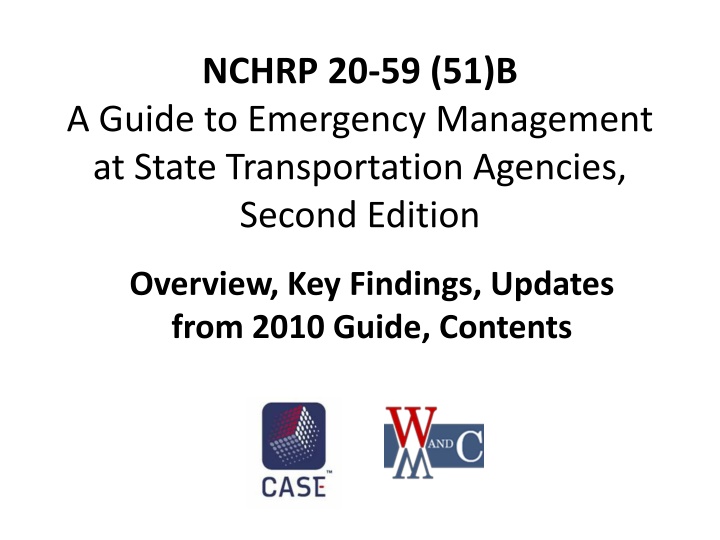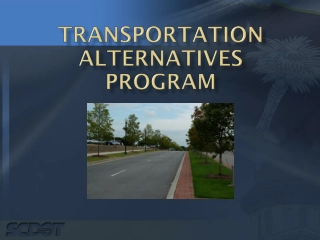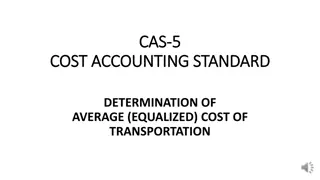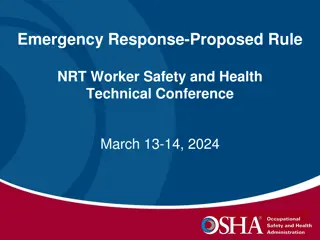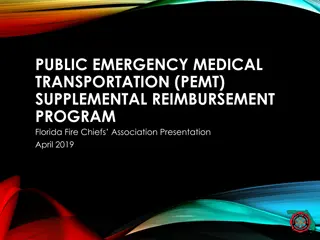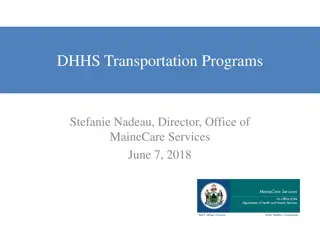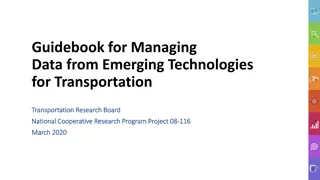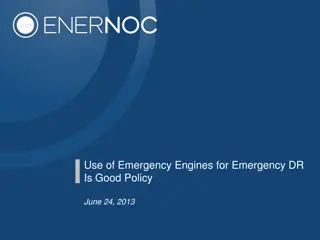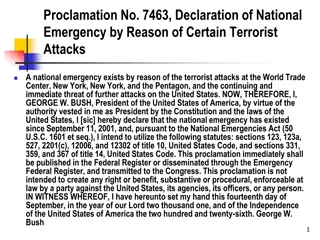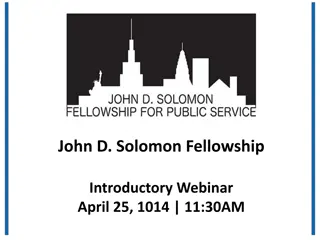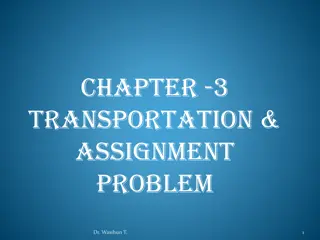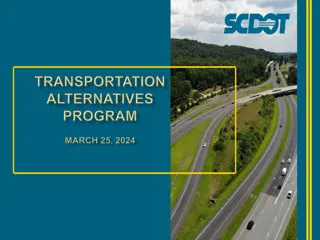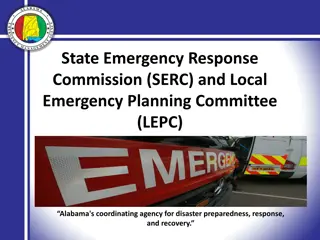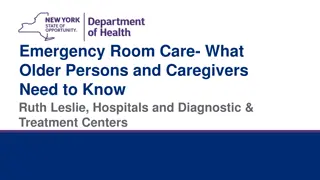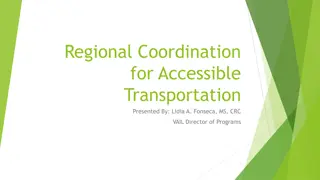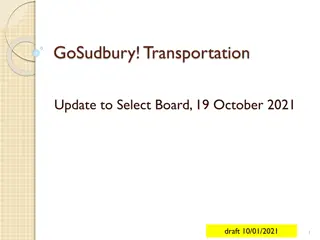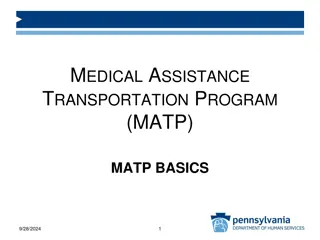Guide to Emergency Management at State Transportation Agencies
This project aims to develop a Second Edition Guide to Emergency Management for State Transportation Agencies, focusing on organizational functions, roles, and responsibilities within the National Incident Management System. The guide will address the latest practices, guidance, threats, hazards, and resources involved in emergency management, with input from various agencies and perspectives. The research approach involves a comprehensive review of domestic and international research, including new technologies and a broad spectrum of hazards. Tasks include meeting with project panels, conducting research reviews, and enhancing emergency response planning for transportation agencies.
Download Presentation

Please find below an Image/Link to download the presentation.
The content on the website is provided AS IS for your information and personal use only. It may not be sold, licensed, or shared on other websites without obtaining consent from the author.If you encounter any issues during the download, it is possible that the publisher has removed the file from their server.
You are allowed to download the files provided on this website for personal or commercial use, subject to the condition that they are used lawfully. All files are the property of their respective owners.
The content on the website is provided AS IS for your information and personal use only. It may not be sold, licensed, or shared on other websites without obtaining consent from the author.
E N D
Presentation Transcript
NCHRP 20-59 (51)B A Guide to Emergency Management at State Transportation Agencies, Second Edition Overview, Key Findings, Updates from 2010 Guide, Contents
Outline Project Overview Objective, Scope Approach Research Approach Findings Key Findings and Updates Guide Guide Contents 2 CASE and Western Management & Consulting
Project Objective 1. Develop Second Edition Guide to Emergency Management at State Transportation Agencies, Second Edition For use by transportation agencies in planning and developing their organizational functions, roles, and responsibilities for emergency management within the all- hazards context of the National Incident Management System (NIMS). Deliverables suitable for adoption by the AASHTO Special Committee on Transportation Security and Emergency Management (SCOTSEM) 2. 3. These products: Reference the latest state of the practice and guidance in emergency management. Focus on DOTs but will also consider local/state/regional users and differing resource levels of small vs. large states. Include guidance of USDOT, FHWA, AASHTO, FEMA, TSA, DHS, and TRB from a state-level perspective. Focus on threats and hazards. 3 CASE and Western Management & Consulting 3
Research Approach Phase 1 CASE and Western Management & Consulting 4
Research Approach Phase 2 CASE and Western Management & Consulting 5
Task 1 - Work Plan Call/Panel Meeting Meet with the project panel to discuss and finalize the working plan. Research team conducted National Operations Center of Excellence (NOCoE) Webinar on May 9, 2016. 6 6 CASE and Western Management & Consulting
Task 2 Domestic and International Research Review Review pertinent domestic & international research on the basis of applicability, conclusiveness of findings, and usefulness for the analytical needs of emergency management and emergency response planning at state transportation agencies. Include relevant completed and in-progress research and information on new technologies. Focus on highway and transit, within all-hazards context. Address expanded list of hazards to be considered, e.g., Extreme Weather, Space Weather, Cybersecurity, Pandemic, Intermodal Issues 7 CASE and Western Management & Consulting 7
Literature Review Focus Updates and changes to the 1st edition of Emergency Response Planning Guide. Catalog current transportation emergency management guidance, strategies and approaches. Identify current emergency management training resources and requirements. 8 CASE and Western Management & Consulting 8
Literature Review Topics Federal and State Emergency Management Requirements Intermodal Transportation Emergency Management Planning and Coordination Current Hazards including Space Weather Coordination role of Metropolitan Planning Organizations (MPOs) along with the role of other local, state, and federal agencies Short- and Long-Term Recovery Planning and Activities Emergency Management Training and Exercises 9 CASE and Western Management & Consulting 9
New Topic: Resilience Resilience is an increasingly important aspect of emergency preparedness and response, and essential in mitigation and recovery efforts. Resilience principles relevant for emergency management: Improve ability to improvise during an event. Add redundancies to system to reroute traffic through one or more parallel components. Have backup components available to quickly replace disrupted function. Plan for potential disruption of interdependent systems power, water, communications, and more. 10 10 CASE and Western Management & Consulting
Selected Highlights of Review Transportation agencies have a broad range of capabilities and responsibilities including a large and distributed workforce, and access to heavy equipment and a robust communications infrastructure. To address these responsibilities, agencies must have a comprehensive emergency management program with all hazards plans that align with their state and regional operations and authorities. Today there are even higher expectations for system performance and reliability and lower tolerance for delays. There is an emerging focus on infrastructure protection and system resiliency as part of security and emergency management. CASE and Western Management & Consulting 11
Selected Highlights of Review Threats and hazards to the system have also continued to evolve. More recently with more and more devastating events due to natural causes, or unintentional or intentional human intervention, there is a greater need for regional collaboration and coordination. Also, with the increased integration of physical and cyber systems, transportation agencies are increasing their focus on cyber risks to prevent cyber attacks on their physical infrastructure and systems. There has been, and continues to be, significant deployment of new resources and rapidly developing technologies to support DOT activities. For example, post-event assessment and recovery have been enhanced by rapidly developing technologies providing digitized data acquisition, storage and transmission. New guidance documents have been issued since the 2010 Guide was released, for example, FHWA primer series Routes to Effective Evacuations and TCRP Report 150: Communication With Vulnerable Populations ,which support evacuation planning and implementation. A considerable amount of research and practice has been documented on recovery strategies. CASE and Western Management & Consulting 12
Selected Highlights of Review National Incident Management System (NIMS) and Homeland Security Exercise and Evaluation Program (HSEEP) updates published since the release of the 2010 Guide provided important new definitions, policy direction and guidance. Emergency management training and exercise tools and resources created since the release of the original Guide included: NCHRP Incident Command System (ICS) Training for Field Level Supervisors and Staff Formalization and implementation of Traffic Incident Management (TIM) training through the SHRP2 program. Development of Transportation Emergency Response Application (TERA), a virtual exercise tool for the training of transportation emergency managers. The establishment of the National Operations Center of Excellence as a resource for the Transportation System Management & Operations workforce. CASE and Western Management & Consulting 13
Task 3 Identify Current Requirements Identify and analyze requirements for state transportation agency planning and response functions, roles, and responsibilities. Examine these requirements over the continuum of emergencies, i.e., Planned activities, minor incident, major incident, hazmat incident, natural disaster, and terrorist incident Specify responsibilities required under NIMS/NRF/NDRF. Encompass all transportation modes under state control or influence. 14 14 CASE and Western Management & Consulting
Selected Highlights of Requirements State DOTs are responsible for creating all-hazards plans and ensuring that employees have the ability to implement them. These plans must conform with and complement the planning activities of other state agencies as well as those of regional authorities. FEMA Comprehensive Preparedness Guide (CPG) provides for development of local, state, tribal, territorial, and insular area emergency operations plans. 2016 NIMS refresh clarifies that NIMS is more than just the Incident Command System (ICS) and that it applies to all stakeholders with roles in incident management across all five mission areas (Prevention, Protection, Mitigation, Response, and Recovery). FIXING AMERICA S SURFACE TRANSPORTATION (FAST) ACTexpands MAP-21 to focus on the resiliency of the transportation system and adds four new eligible categories including reconstruction, resurfacing, restoration, and rehabilitation. Emergency training and exercise needs stem from federal, state, local, and industry requirements. 15 15 CASE and Western Management & Consulting
DOT Roles in Emergency Management National Disaster Recovery Framework (NDRF) published in 2011 and updated in 2016 Defines an overall recovery process for communities. Includes core recovery principles, Recovery Support Functions (RSFs), recovery coordinators, other stakeholders, and pre-and post-disaster recovery planning guidance. The Infrastructure Systems RSF helps restore infrastructure systems and services to support a sustainable community, and increases resilience to and protection from future hazards. 16 16 CASE and Western Management & Consulting
DOT Roles in Emergency Management National Response Framework (NRF) published in 2008, updated in 2013 and 2016 Is the doctrine under which the Nation provides all hazards response and provides the coordinating structures for delivering core capabilities. Aligns key roles and responsibilities at all levels of government, private industry, and NGOs into a unified national response. Contains the base document, Emergency Support Function (ESF) Annexes, and Support Annexes. Identifies the critical role of transportation in response. The DOT is the lead agency for ESF-1, Transportation. 17 17 CASE and Western Management & Consulting
DOT Roles in Emergency Management National Preparedness Goal (NPG) published in 2011 and updated in 2015 The updated NPG emphasized community preparedness and resilience under the Mitigation mission area and imminent terrorist threats under the Prevention mission area. STRATEGIC NATIONAL RISK ASSESSMENT (SNRA) RESULTS Potential worsening of the consequences of natural hazards (e.g., flooding, droughts, and wildfires). Terrorism threats include attacks by lone actors and use of weapons of mass destruction by terrorist organizations. Technological and accidental hazards including transportation system failures, dam failures, and chemical spills or releases can cause severe consequences particularly when combined with aging infrastructure. Pandemic influenza along with other human and animal infectious diseases has the potential to decimate Americans. Cyber attacks can be catastrophic and cause cascading consequences. 18 18 CASE and Western Management & Consulting
DOT Roles in Emergency Management National Infrastructure Protection Plan (NIPP) published in 2006, updated in 2009 and 2013 VISION A Nation in which physical and cyber critical infrastructure remain secure and resilient, with vulnerabilities reduced, consequences minimized, threats identified and disrupted, and response and recovery hastened. (NIPP, 2013) Incorporates requirements of PPD-21 on Critical Infrastructure Security and Resilience, and focuses on merging cyber and physical security efforts Provides coordinated approach to Critical Infrastructure/Key Resources protection Stresses information-sharing and cross sector and cross jurisdictional coordination Recognizes importance of critical infrastructure owners and operators, and government, private, and nonprofit sectors 19 19 CASE and Western Management & Consulting
DOT Roles in Emergency Management Transportation System Sector Specific Plan (TSSSP) Annex to NIPP published in 2010, updated in 2015 Guides and coordinates the critical infrastructure risk management, protection, security and resilience efforts. Identifies and prioritizes Sector risks. SECTOR RISKS Natural disaster risks include increased risk to transportation infrastructure due to extreme weather events and coastal transportation infrastructure due to sea level rise and storm surges. Manmade physical threats - terrorism, vandalism, theft, technological failures, and accidents Increased manmade cyber risk due to increased use of connected control, navigation, and communications systems. Aging and deteriorating infrastructure diminishes resilience and is also considered a risk. 20 20 CASE and Western Management & Consulting
DOT Roles in Emergency Management Transportation System Sector Specific Plan (TSSSP) Annex to NIPP published in 2010, updated in 2015 Identifies strategies to address the risks. Establishes measures of effectiveness and reporting requirements for co-SSAs. The DOT along with TSA became the co-sector specific agency for the Transportation System Sector with expanded security roles and responsibilities. 21 21 CASE and Western Management & Consulting
DOT Roles in Emergency Management Transportation System Sector Specific Plan (TSSSP) Annex to NIPP published in 2010, updated in 2015 Goal 1: Manage the security risks to the physical, human, and cyber elements of critical transportation infrastructure. Goal 2: Employ the Sector s response, recovery, and coordination capabilities to support whole community resilience. Goal 3: Implement processes for effective collaboration to share mission-essential information across sectors, jurisdictions, and disciplines, as well as between public and private stakeholders. Goal 4: Enhance the all-hazards preparedness and resilience of the global transportation system to safeguard U.S. national interests. (TSSSP, 2015) SECTOR GOALS 22 22 CASE and Western Management & Consulting
Task 4 Review Current Practices Review current practices of state transportation agencies in meeting responsibilities identified in Task 3. Assess usefulness of available guidance. Describe the range of state transportation agency emergency management planning and implementation practices. Include selected case studies illustrative of the range of state practices. CASE and Western Management & Consulting 23 23
Selected Highlights of Practices Transportation planning for emergencies is commonly addressed in regional or state plans and annexes. Re-entry and recovery plans were less common regional practices. There is a lack of planning for using available transportation modes in emergencies and other events. Collaboration on transportation planning for disasters and emergencies was more common than for planned events. Coordinated communication planning with nongovernmental organizations was not a widespread practice. State DOT emergency operations plans reflect the state DOTs roles and responsibilities in the Transportation Emergency Support Function (ESF-1) and the Public Works and Engineering Emergency Support Function (ESF-3). Over time there has been an evolution in the preferred methods of training delivery for DOT employees. 24 24 CASE and Western Management & Consulting
Survey Results: Recommended Training 80% of the survey respondents indicated that their organization required or encouraged emergency preparedness training. No other types of training had substantially higher levels of response. 25 25 CASE and Western Management & Consulting
TRAINING STRATEGY DESCRIPTION Field Crew Meetings Meetings are regularly scheduled alleviating scheduling issues. Held in district locations and during times convenient to field personnel. Just-in-time training (JITT) Useful for specific skills training not regularly required - for example, disaster reimbursement application procedures. Interjurisdictional and interagency training and exercises Used to prepare for large, complex disasters and emergencies. Involves multiple state and regional agencies; may also include relevant private and nonprofit organizations, community groups, and other stakeholders. Provide opportunities for personnel to meet, interact, train, and exercise with personnel from other agencies and jurisdictions. Combining related training topics alleviates scheduling challenges. Enhances intra-agency interactions. Examples include combining ICS training with incident management or winter maintenance training. In fact, the new SHRP 2 National TIM Responder Training course contains ICS training content. Joint training 26 26 CASE and Western Management & Consulting
TRAINING STRATEGY Asynchronous Training DESCRIPTION Self-paced training, no instructors. Requires self-discipline. Examples include YouTube videos, prepackaged CDs/DVDs. Leverages training resources. In-house trainers/qualified personnel are trained, and subsequently provide the training to other personnel. Especially useful in training large workforces. Train-the-trainer (TTT) Planned Events, Incidents, and Exercises Provide opportunities for personnel to practice their training and skills. After-action reports and improvement planning identify additional training needs and gaps for individual field personnel and teams, and scenarios for future training. Computer Simulations and Virtual Exercises Allow real-time interaction in realistic but safe environments. Delivery through web-based or non-web-based technologies. Provision of simulated players possible. On demand exercise play is possible. 27 27 CASE and Western Management & Consulting
Helpful Training Tips Determine who (what positions) need what type of EM training including NIMS Core Curriculum training. Training should progress from individuals to teams to interagency/ interjurisdictional exercises. Establish relevant professional qualifications, certifications, and/or performance standards. Ensure content/methods comply with applicable standards, produce required skills, and measurable proficiency. Incorporate NIMS/ICS into all training and exercises. Ensure all personnel with a direct EM role complete the designated FEMA training. Establish or leverage partnerships with other agencies and organizations. Identify community training needs to support response and evacuation/shelter in place/quarantine activities. Make the training as interactive as possible. Make the training specific and relevant to real world problems. 28 28 CASE and Western Management & Consulting
Helpful Training Tips Acknowledge experience and knowledge by encouraging sharing of knowledge, information among training participants. Provide a chance for learners to reflect on their training. Then, shortly thereafter, provide opportunities to apply new learning. Maintain comprehensive training records, following applicable standards . Connect with the NIC for guidance on NIMS/ICS personnel training. The FHWA Peer to Peer (P2P) program offers technical assistance, training and education on TIM/planned special event planning, procurement, deployment, and operations. Leverage professional organization memberships and events for training and certification. Job aids and on the job learning can help with training retention and recall. Technologies such as VOIP and VTC can broadcast classroom instruction to other districts or regional offices. Minor incidents provide training and practice opportunities. 29 29 CASE and Western Management & Consulting
Task 4 Case Studies Agencies/Topics Agencies/Topics Louisiana DOTD Numerous improvements in emergency response based on lessons learned from Hurricanes Katrina and Isaac; Pre disaster, pre event inspection and documentation of transportation asset conditions; Asset tracking of transportation resources from mobilization through demobilization; and Explicit plans and procedures for emergency transportation for people with access and functional needs. DOTD practices support the local evacuation practices throughout the state. California (Caltrans) Overview of Caltrans Emergency Training & Exercise Program Technologies for emergency response and recovery Emergency communications Emergency Management Common Operational Picture (EMCOP) Role of MPOs in emergency management coordination San Francisco Bay Area MPO s roles in regional emergency planning and information sharing. CASE and Western Management & Consulting 30
Task 4 - Case Studies Agencies/Topics Iowa DOT Iowa DOT s real time weather and operations information and its role in enhancing safety; Resource Management System modules allowing Iowa DOT to increase the efficiency of reimbursement processes and make cost recovery from small disasters cost effective; and, Electronic Detailed Damage Inspection Reports (DDIRs). Agencies/Topics Tennessee DOT Tennessee DOT s emergency management roles and responsibilities and emergency management plan; A synopsis of the DOT s training and exercise program including the Comprehensive Exercise Program; Process Milestone Tracking to track/monitor emergency repair projects; and, Bridge Monitoring Tool for prioritizing and scheduling disaster assessments. CASE and Western Management & Consulting 31
Tasks 5 & 6 Outline & Work Plan Task 5 Prepare Detailed Outline and Phase II Work Plan Task 6 Prepare Interim Report Principles for Guide Development Will reorganize, restructure and consolidate the Guide Will make the report more concise and user-friendly, and take a higher-level approach to the topics Will meet the expanded project objectives and scope in the broader context of Emergency Management 32 32 CASE and Western Management & Consulting
Guide Development Deliverable Schedule Initial Draft Guide Stakeholder Review Final Guide Preparation Tasks Development Tasks Collect materials Production Tasks Revise/refine content Plan modules Revise material Contact potential reviewers Format & edit Create print quality version 33 33 CASE and Western Management & Consulting and Western Management & Consulting CASE
Phase 2 Tasks 7, 8, & 9 Implementation Final deliverables The Second Edition Guide; Final report; Interim meeting PowerPoint presentation; 1-page executive summary; and Task 8 implementation technical memorandum. 34 34 CASE and Western Management & Consulting
Original Table of Contents Section 1: Introduction Section 2: Institutional Context for Emergency Response Section 3: Assess Agency Status in Emergency Response Training Section 4: Develop an Emergency Preparedness Program Section 5: Nature and Degree of Hazards/Threats Section 6: Resource Guide Appendices A. Guide to using Portions of the 2002 Guide B. Emergency Response Legal Authorities C. Emergency Response Stakeholder Responsibilities D. Key Emergency Response Definitions E. Key Traffic Incident Definitions F. Intelligence Fusion Centers G. Transportation Emergency Response Effects Tracking (TERET) H. Model Emergency Operations Plans I. Policy and Procedural Memoranda and Memoranda of Understanding J. Training/Exercise Plans CASE and Western Management & 35 35 Consulting
Guide Revisions Met expanded project objectives and scope in the broader context of Emergency Management. Title Changed from Emergency Response Planning to Emergency Management All-Hazards Approach Reorganized, restructured, and consolidated the Guide More concise and user-friendly High Level Approach vs. Detailed How To Planning Orientation 36 36 CASE and Western Management & Consulting
Table of Contents: Sections Original TOC Section 1: Introduction Section 2: Institutional Context for Emergency Response Section 3: Assess Agency Status in Emergency Response Training (now Chap 6) Section 4: Develop an Emergency Preparedness Program Section 5: Nature and Degree of Hazards/Threats (now Chap 3) Section 6: Resource Guide/Self- Assessment (now Appendix) Updated TOC Chapter 1: Introduction Chapter 2: Institutional Context for Emergency Management Chapter 3: Nature and Degree of Hazards/Threats Chapter 4: Develop an Emergency Preparedness Program Chapter 5: Stakeholders and Regional Collaboration (NEW) Chapter 6: Training and Exercises (EXPANDED) CASE and Western Management & Consulting 37
Table of Contents: Appendices Original TOC A. Guide to using Portions of the 2002 Guide (Outdated) B. Emergency Response Legal Authorities (now in Chap 2) C. Emergency Response Stakeholder Responsibilities (now in Chap 5) D. Key Emergency Response Definitions (now in D Glossary) E. Key Traffic Incident Definitions (now in D Glossary) F. Intelligence Fusion Centers (now in A Resource Guide) G. Transportation Emergency Response Effects Tracking (TERET) (Outdated) H. Model Emergency Operations Plans (now in B Examples) I. Policy and Procedural Memoranda and Memoranda of Understanding (now in B Examples) J. Training/Exercise Plans (now in B Examples) Updated TOC A: Resource Guide B: Case Studies C: Acronyms, Abbreviations, and Initialisms D: Glossary E: Tennessee DOT Needs Assessment F: Example Materials from Transportation Agencies and Western Management & Consulting CASE 38
Table of Contents Executive Summary Chapter 1: Introduction Chapter 2: Institutional Context for Emergency Management Chapter 3: Nature and Degree of Hazards/Threats Chapter 4: Develop an Emergency Preparedness Program Chapter 5: Emergency Management Stakeholders and Regional Collaboration Chapter 6: Emergency Management Training and Exercises CASE and Western Management & CCASE and Western Management & Consulting lting 39 39
Table of Contents Appendix A: Resource Guide Appendix A1: Annotated Bibliography Appendix A2: Fusion Centers Appendix A2: Information Sharing Analysis Centers (ISACs) Appendix A3: Plan Checklist Appendix A3: Prepare Checklist Appendix A3: Respond Checklist Appendix A3: Recover Checklist Appendix A3: NIMS Compliance Issues Appendix A4: Checklist of Potential Transportation Assets (High Level) Appendix A4: Checklist for Inter Agency Communications and Information Sharing Appendix A4 Checklist for Emergency Events Affecting Multiple Jurisdictions, Transportation, And Interdependencies Appendix A4: Checklist of Potential Stakeholders Appendix A4: Transportation Resources Detailed Checklist Appendix A4: Strategies to Exercise Regional Transportation Plan for Disasters, Emergencies and Significant Events Checklist Appendix A5: Agency Resources Contact Sheet Template Appendix A5: Agency Contact Sheet Template Appendix A5: Summary of Full After Action Report Template Appendix A6: Collaboration and Coordination Guides CASE CCASE and Western Management & and Western Management & Consulting lting 40 40
Table of Contents Appendices B-F Appendix B: Case Studies Appendix C. Acronyms, Abbreviations, & Initialisms Appendix D: Glossary Appendix E: Tennessee DOT Needs Assessment Appendix F: Example Materials from Transportation Agencies CASE CCASE and Western Management & and Western Management & Consulting lting 41 41
Further Research Needs Understanding resilience and emergency management and the impact that relationship has on the roles, needs and capabilities of state DOTs. More specifically, understanding how resilience can be built into recovery efforts and into mitigation planning. Better understanding and documentation of the benefits of mitigation and resilience. What are documented financial and economic benefits from transportation investments that foster resilience? the relationship between 42 42 CASE and Western Management & Consulting
Further Research Needs Understanding the interdependencies of all transportation modes and other sectors such as power, water, communications on emergency management and the impact on state DOTs and other transportation agencies. Understanding the impact of cascading events on transportation emergency management planning, response and recovery. Research on emergency management approaches to address concurrent events or events that have an impact on an extensive area or region. 43 43 CASE and Western Management & Consulting
Further Research Needs Understanding how to identify and train the resources needed to carry out all-hazards resilience-focused emergency management, recognizing that it is difficult for most transportation agencies to allocate significant personnel, monetary, and material resources to planning and training for events that occur on infrequent bases or may not occur in their state or region. 44 44 CASE and Western Management & Consulting
Thank You For additional information please contact: Ron Frazier ronfrazier@caseexperts.com Jeff Western Jeffrey.Western@consultingwestern.com 45 CASE and Western Management & Consulting
